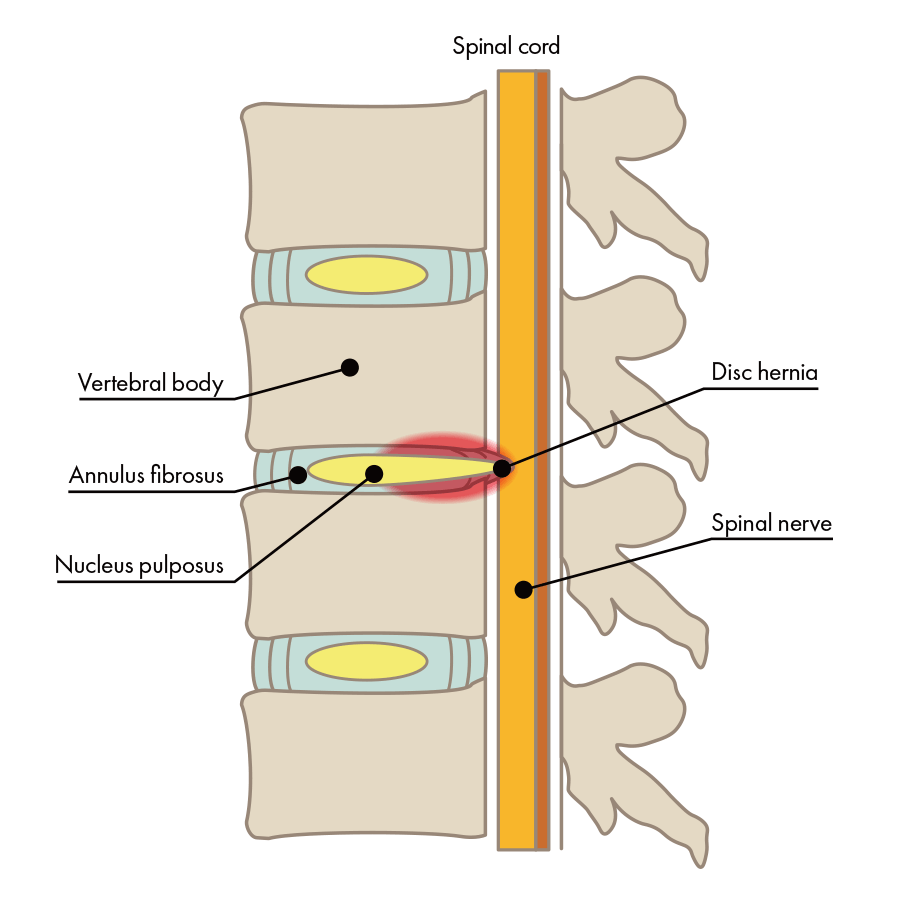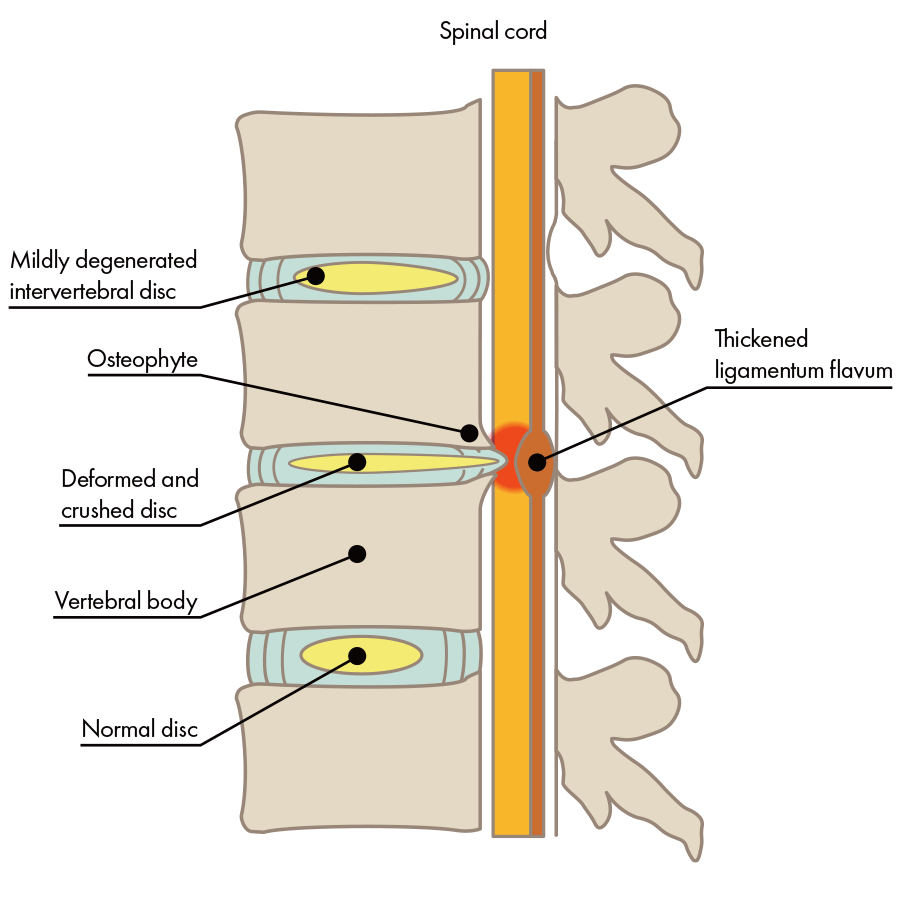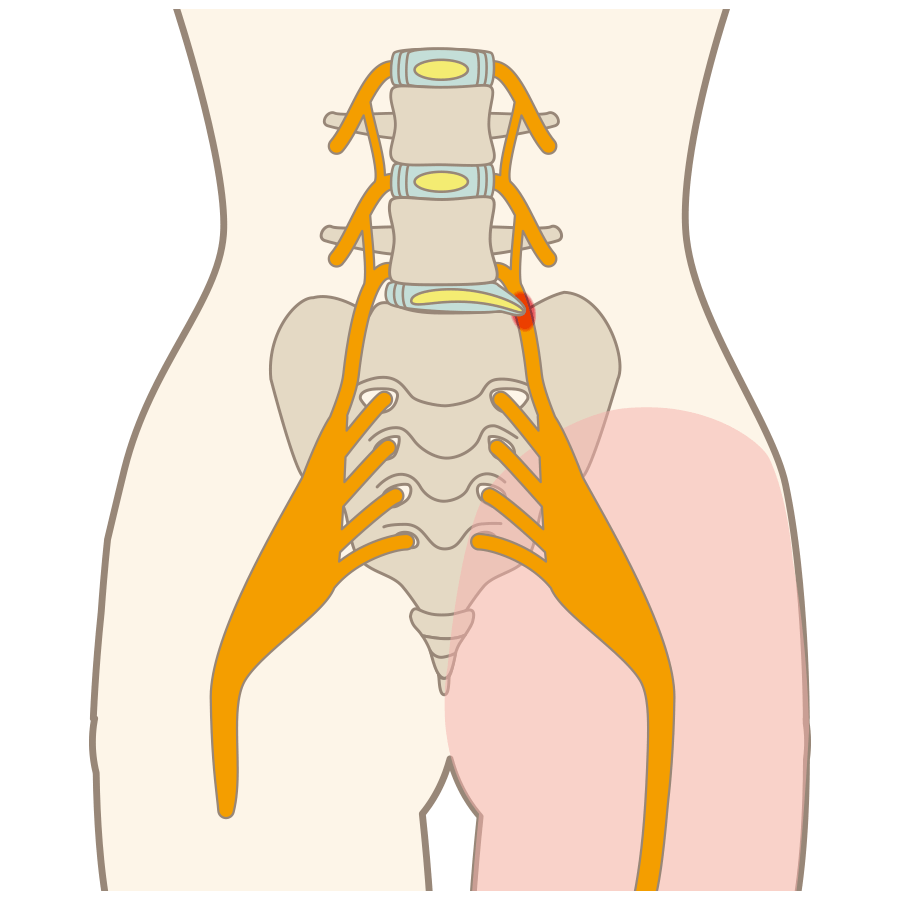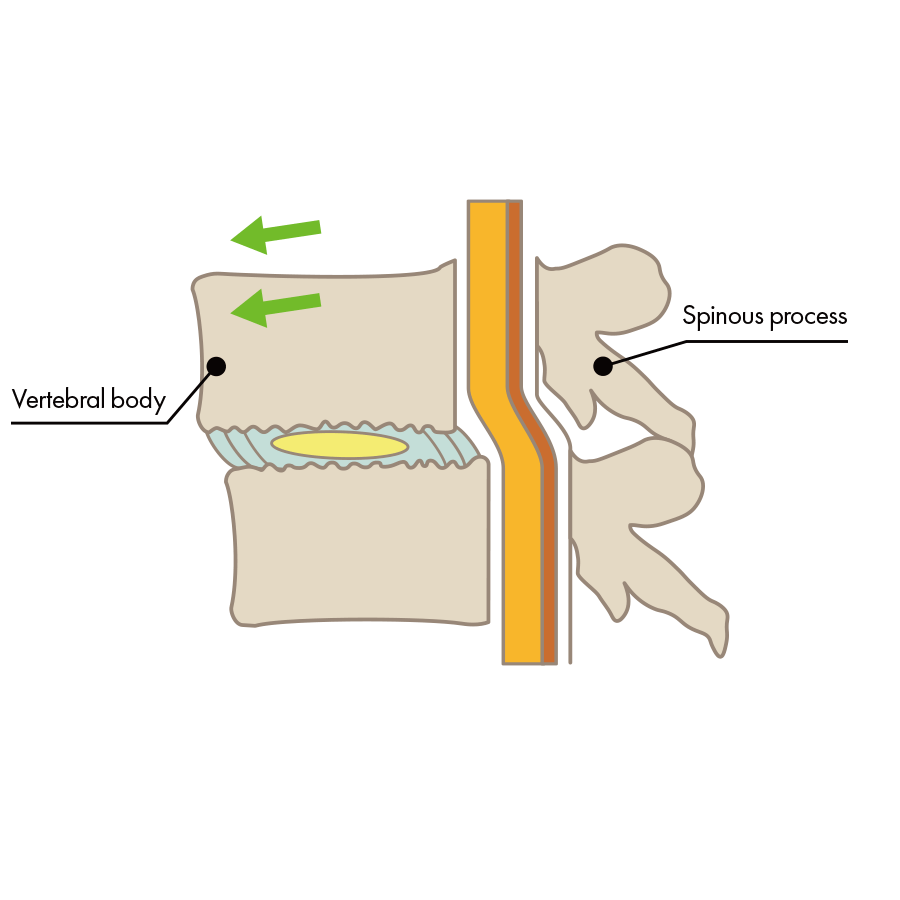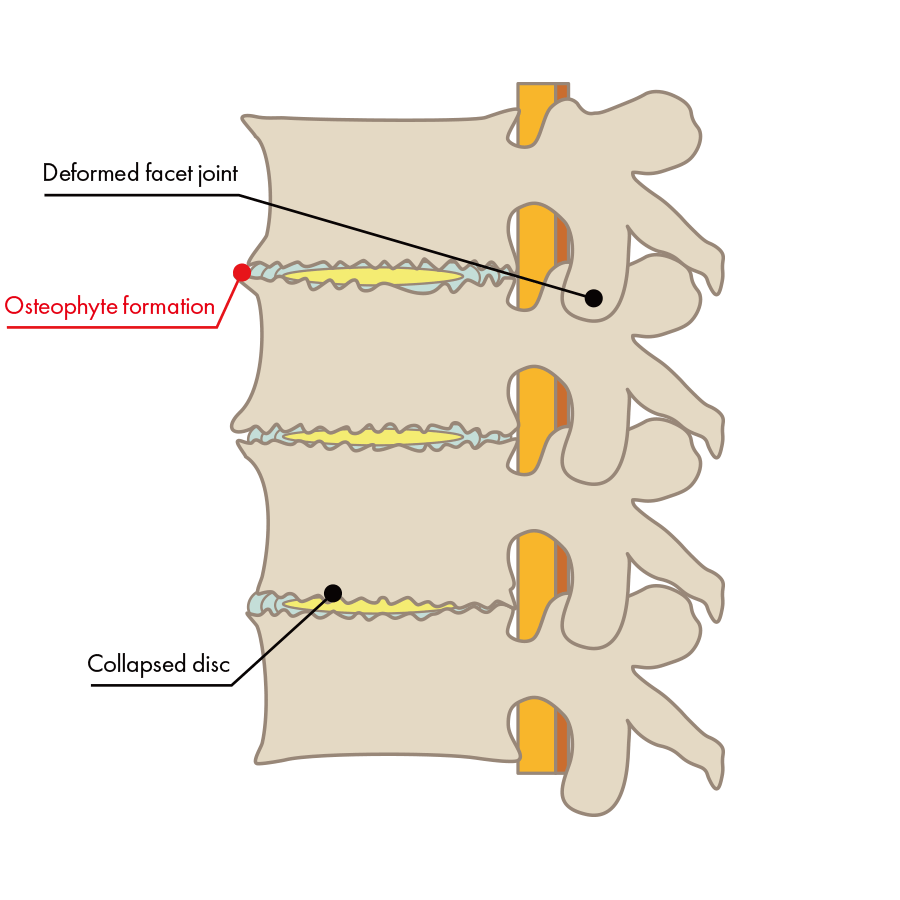Spondylolisthesis/ Targeted Conditions
What is spondylolisthesis?
Bones may sometimes shift in place due to abnormalities in the spinal joints called the facet joints or in the intervertebral discs, and this condition is called "spondylolisthesis". The two types of spondylolisthesis comprise an “anterior slip" where the bone slides forward and a "posterior slip" where the bone slides backward. It is usually said that most spondylolisthesis are caused by anterior slip. Most of spondylolisthesis cases fall either in the category of "lumbar degenerative spondylolisthesis" or "spondylolytic spondylolisthesis". The symptom of low back pain caused by the position of the lumbar spine deviating from its original position is called "lumbar degenerative spondylolisthesis". On the other hand, the strain occasioned by a spine which has shifted from its original position can lead to cracks in the protrusions behind the lumbar spine, and the resulting instability of the entire lumbar spine is called lumbar spondylolytic spondylolisthesis. Although the exact cause is unclear, most patients seem to have practiced a sport in their youth, and as the discs tissues that hold the lumbar spine in place, such as the vertebrae, ligaments, and joints, degenerate with age, the ensuing loss of stability in the lumbar spine is believed to lead to spondylolisthesis.
Degenerative Spondylolisthesis
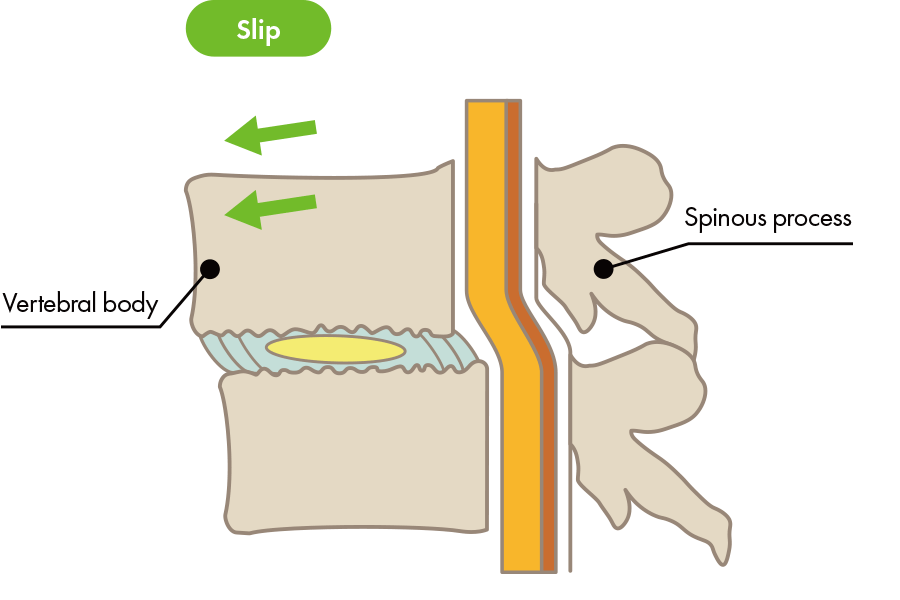
The symptom of low back pain that appears when a lumbar vertebra slips out of its original position is called lumbar degenerative spondylolisthesis. When the intervertebral discs degenerate, they are unable to keep their original shape and slip forward, causing inflammation around the nerves, which may result in symptoms of intermittent claudication.
Spondylolytic Spondylolisthesis
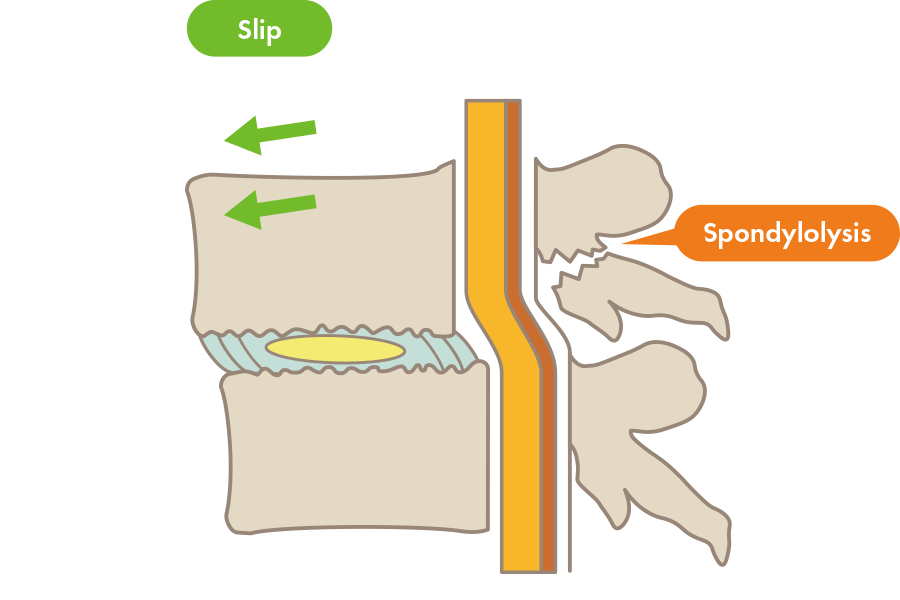
When a vertebra shifts from its original position the excessive pressure on the lumbar process may cause to crack, and the entire lumbar spine to become unstable. This condition is known as lumbar spondylolysis. Spondylolysis often leads to spondylolytic spondylolisthesis, which can cause various symptoms such as back pain, etc.
Although the exact cause is unknown, it is believed that tissues as vertebral discs, ligaments and facet joints that hold together the lumbar spine slowly degenerate with age as a result of playing sports at young age, which causes loss of stability and results in lumbar spondylolisthesis.
Those who suffer from spondylolisthesis should avoid strenuous exercise and movements such as twisting and bending of the lower back as much as possible. In addition, people with spondylolisthesis should refrain from doing anything that puts strain on the lower back in daily life.
What are the symptoms of spondylolisthesis?
Symptoms include numbness or pain in the buttocks and thighs after walking only for a short distance. After a short break, the patient is usually able to walk again, but the repeated alternance of walking and resting episodes is a characteristic symptom of spondylolisthesis. In the case of spondylolisthesis, the nerve canal that run behind the lumbar spine may become misaligned and lead to nerve compression, resulting in symptoms similar to spinal canal stenosis. Once a lumbar spine is out of alignment, the lumbar vertebra will not return naturally, so once it has slipped, it may prove difficult to restore to normal.
How is spondylolisthesis diagnosed?
Misalignment of the lumbar spine is diagnosed by x-ray examination. The degree of nerve compression is diagnosed by MRI.
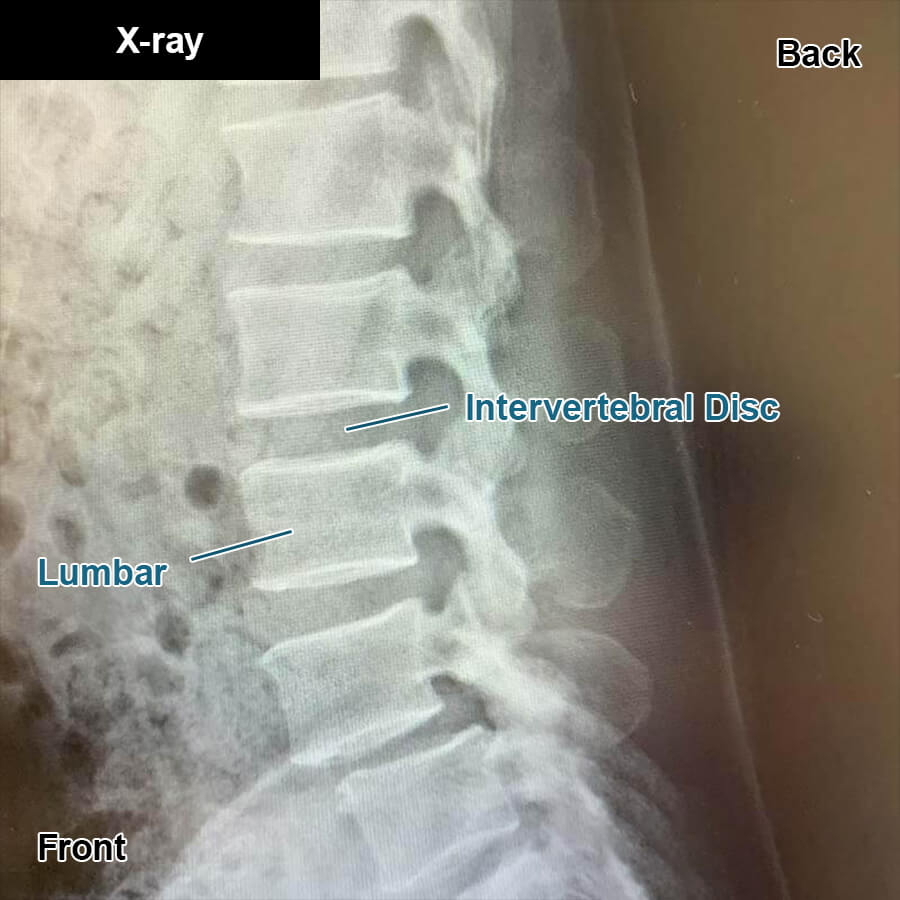

Surgical treatment for spondylolisthesis
Lumbar Laminectomy
This is a surgical procedure to widen the narrowed lumbar spinal canal caused by stenosis. There are two types of laminectomy: wide laminectomy, in which the vertebral arch is extensively resected, and partial laminectomy, in which only the part of the vertebral arch that stands in way of passing the endoscope is removed. When wide lumbar laminectomy is performed, a 4 cm skin incision on the back is made and after the the muscle is detached from the bone, the lumbar vertebral arch is cut out, and the thickened part of the yellow ligament that causes the stenosis is removed. During partial laminectomy, after making an incision of 1.5 cm to 2 cm in the skin, a 1.2 ~1.8 cm wide surgical instrument with a camera attached to its tip is inserted into the spine. The whole process of removing a portion of the vertebral arch, ligaments etc. to decompress the nerve is monitored on an external screen.
Advantages of Lumbar Laminectomy
When partial lumbar laminectomy is used, due to the narrow incision, the wound is small and the patient can leave the hospital in about a week.
Disadvantages of Lumbar Laminectomy
In the case of partial lumbar discectomy, the incision is narrower, but the field of vision is also limited, so the procedure cannot be performed if there are multiple areas of stenosis or if the vertebrae are not stable. In the case of wide laminectomy, the incision is wider and the risk of infection and complications is higher. Furthermore, revision surgery may not be possible after wide laminectomy has been done.
Spinal Fusion Surgery
Spinal fusion is a surgical procedure that uses medical devices such as plates, screws, rods and spacers to fix a part of the spine that is suffering from spinal canal stenosis. General anesthesia is performed and an incision is made in the skin of the back. A part of the spine called the vertebral arch and the facet joints are cut out, and the intervertebral disc and ligamentum flavum are removed. A spacer is inserted in place of the disc, and a plate is set and fixed with rods and screws.
Advantages of Spinal Fusion Surgery
This surgical procedure is used to treat a wide range of lumbar spine diseases including spinal canal stenosis and disc herniation etc. Since it immobilizes the spine, it can be effective in cases where the lumbar spine is unstable.
Disadvantages of Spinal Fusion Surgery
Postoperative rehabilitation is required, which makes a hospital stay of approximately one month inevitable. The risk of infection and complications is higher in spinal fusion surgery than in minimally invasive surgery due to the wider incision and longer operation time, and patients may experience discomfort and pain due to postoperative rehabilitation and immobilization. Similar to the MEL method, it is a surgical operation that makes conditions difficult to re-operate.
Conservative treatment of spondylolisthesis
Since the lumbar spine is unstable, the use of corset to support it, and painkillers or block injections are considered. In addition, there are methods to train and strengthen the core muscles, ligaments, and joints that support the lower back. Conservative treatment does not completely eliminate the pain because it is not a fundamental treatment. If conservative treatment does not improve the pain and numbness, or if the symptoms are so severe that they interferes with daily life, surgery may be considered.
If there is no improvement at all with conservative treatment, or if the pain and numbness are so strong that they interere with the patient's daily life, surgical operation may be considered.
Risks associated with spondylolisthesis surgery
There is some risk that lumbar fusion and posterior lumbar decompression damage nerves and blood vessels. There is also a risk that the patient may contract an infectious disease and get suppuration due to bacterial infection in the operated area. With spinal fusion, a shift in the lumbar vertebra may occur due to a damaged fixation device or loosened screws. Alternatively, there is a risk that the patient's allergic predisposition may be overlooked due to lack of prior communication with the doctor, and an allergic reaction due to metal or artificial materials may occur after surgery. In addition, attaching a fixation device may induce symptoms such as an odd feeling, a sense of weariness, and pain in the lower back that can last for as long as a year for some people. Since bending and twisting the back may be difficult after fusing the spine, some movements of daily life may become limited in scope.
How is our clinic’s treatment effective for spondylolisthesis?
Lumbar fusion and posterior lumbar decompression may not be an option if surgery poses a high risk to the patient, or for those who already had surgery once but need to be treated again. At our clinic, we offer The Discseel® Procedure as a treatment for spondylolisthesis. Elder patients who are at high risk during surgery or those who wish to undergo a second surgery may also benefit from The Discseel® Procedure. By repairing and regenerating the degenerated intervertebral disc, it is possible to prevent the progression of spinal misalignment that is the cause of spondylolisthesis. It can also stabilize an unstable spine, such as one affected by spondylolytic spondylolisthesis, and prevent the onset of pain.
Treatment Overview
The Discseel
Discseel® Procedure
Discseel® Procedure was developed by an American surgeon by the name of Dr. Kevin Pauza, after caring for hundreds of patients who were made worse following their spine surgery. The treatment aims to seal tears in herniated vertebral discs and help them regenerate and recover their, allowing permanent relief of back pain. Dr. Pauza holds a series of 16 patents for a device and Discseel® biologic that support the treatment. Dr.Nonaka has been licensed to perform the Discseel® Procedure in 2018, and more than 2,880 patient have undergone the treatment in our clinic since then. At present, approximately 20 doctors, including physicians from Harvard and Boston Universities are using the Discseel® Procedure to treat their patients in the USA. Dr. Nonaka is the first physician trained to perform the Discseel® Procedure in Japan.

Spondylolisthesis: FAQ
-
- Q
-
Does Spondylolisthesis distort the entire spine?
- A
-
Yes, as the Spondylolisthesis progresses, other back conditions may arise. Spinal stenosis, which puts pressure on the nerves and narrows the nerve pathways, and disc deformities, may lead to disc heniation.
-
- Q
-
Is spondylolisthesis more likely to occur with a poor posture?
- A
-
This can be one of the causes. But it is not the only cause, and you need to ask yourself if you are in an uncomfortable position due to aging or your daily work environment. It is important to be careful not to put unnecessary burden on the back.
-
- Q
-
Is there any way to alleviate the pain caused by spondylolisthesis?
- A
-
In case of mild spondylolisthesis symptoms can alliviated through syndrome can be alleviated by physical rehabilitation and medication therapy, but the condition has already progressed and the symptoms are severe, surgical operation can be considered. At our clinic we offer outpatient back pain treatment options for elderly patients who have difficulty undergoing surgical procedures or who are at risk of complications.
-
- Q
-
Are there any movements I should avoid with spondylolisthesis?
- A
-
If you suffer from anterior spondylolisthesis, avoid bending your body backwards. Also, if you have posterior spondylolisthesis, you must be careful not to make any movements bending forward.
-
- Q
-
Is there any way to prevent Spondylolisthesis?
- A
-
Try to avoid movements that put strain on your back. If you have been diagnosed with a condition such as herniated disc(s) or spinal stenosis, you especially should be performing back pain training on a regular basis, and we also recommend walking or other moderate amounts of physical activity.
-
- Q
-
Is there a way to fast track recovery from Spondylolisthesis?
- A
-
Recovery is estimated to take between six months to a year, depending on the person. And even if the pain or numbness improves, the time to recovery will usually depend on the original symptoms and general condition.
Targeted Conditions
-
Disc Herniation

-
Spinal Canal Stenosis

-
Sciatica

-
Spondylolisthesis

-
Disc Degeneration

-
Lumbar Spondylosis

- HOME/
- Targeted Conditions/
- Spondylolisthesis

